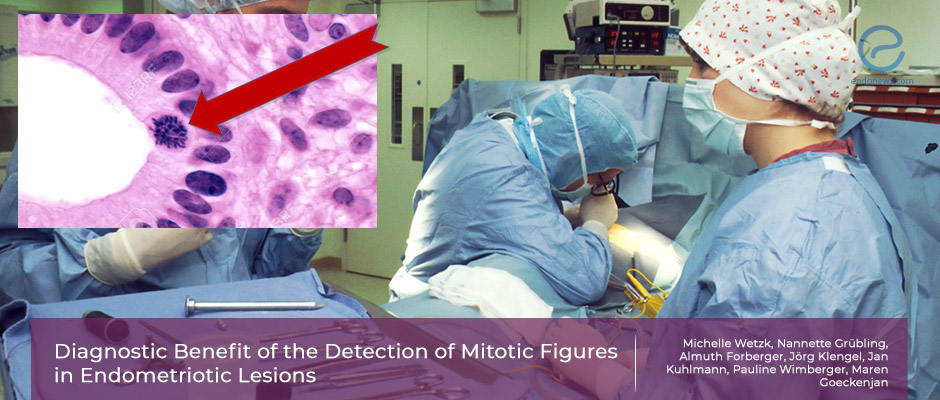The relevance of mitosis in endometriotic tissue biopsies
Feb 7, 2022
Mitotic activity in endometriosis
Key Points
Highlights:
- The diagnostic gold standard of endometriosis is histopathologic assessment, i.e. microscopic examination of tissue biopsies by histopathologists.
- However, the presence of mitotic activity in endometriosis samples of diagnostic biopsies was not evaluated until recently.
Importance:
- Mitotic activity is a simple microscopic feature that could yield additional information for many pathologic conditions, without any additional costs.
- It may be a scientifically valid hypothesis that mitotic activity could yield additional diagnostic value in endometriosis as well.
What's done here:
- This is a retrospective study in which the mitotic activities and clinical data of 542 patients with biopsy-proven endometriosis were analyzed.
- One-fourth (n=140) had at least one mitotic figure and were compared to the control group (n=402) who had no mitotic figure in their biopsies.
Key results:
- There were no significant differences between the two subgroups in terms of infertility, however, endometriosis diagnosis during surgery was more frequent in the group without mitosis.
- The plan for surgery was significantly more often because of acute or chronic pain in the subgroup with mitotic figures.
- Mitotic figures were common in patients with deep infiltrating endometriosis, ovarian endometrioma, infertility, and multiple endometriotic lesions.
- There was no significant difference in mitosis in the biopsies of women with or without concurrent hormonal treatment.
- Assessment of mitotic activity helped in detecting advanced stages of endometriosis, however, any supportive information on endometriosis-related malignancies has not been disclosed.
Limitation of the study:
- The percentage of women with deep infiltrating endometriosis in this series is 19.0% which may reflect a selection bias.
- The large sample size, information on symptoms, reproductive health, and medical histories, are the strengths.
Lay Summary
Dr. Wetzk and co-workers from the Technical University, Dresden, Germany have published a retrospective study on the diagnostic impact of mitotic activity in the endometriotic lesion biopsies in the recent issue of the journal “Geburtshilfe und Frauenheilkunde”.
Guidelines highly recommend a microscopic assessment, i.e. sending biopsies to the pathology laboratory after surgical procedures to make a diagnosis of endometriosis precisely. However, the current guidelines do not have clear statements about the specific procedures for this histopathological evaluation.
This retrospective study carried out at a university endometriosis referral center located in Dresden, Germany assessed the diagnostic impact of mitotic activity as a marker of proliferation in endometriotic biopsies. A total of 542 patients with histologically diagnosed endometriosis were analyzed. The results revealed that the patients with mitotic figures are more likely to have a higher endometriosis stage, deep infiltrating endometriosis, ovarian endometrioma, and infertility.
The authors suggest that women in whom mitotic figures are detected in their biopsies should have shorter postoperative follow-up intervals and additionally the time to pregnancy in cases of infertility should be shortened. Assisted reproductive techniques could be proposed earlier for women with mitotic figures. "....further studies should be carried out to investigate the association between mitotic rate and the rate of recurrence after the initial diagnosis of endometriosis and pregnancy outcomes in women with infertility", they added.
Research Source: https://pubmed.ncbi.nlm.nih.gov/35027863/
endometriosis biopsy histopathology mitotic activity

